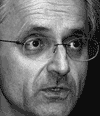A dark, and almost, not quite, not yet, hermetic text, with impassioned invitation (urging the reader/listeners, the faithful?) to join the Dance: The poem makes words join the round dance.
A suggestive and sensual text that doesn’t give much away, yet managing to be both excluding and including. If it is “about” Europe, then it is a dancing and singing Europe.
I admire the strong sense of, and emphasis on, form - for example, with the anaphoric beginning of lines - “on this day” - functioning as a leitmotiv, it seems.
Apart from verse, rhythm and rhymes, there is a strong visual element that binds the text together. “Visual” rhymes (brother, other, author; maybe in some regional dialects not just visual?; traces, graces embraces: cunningly binding ideas, thoughts, images that cut across the lines).
The most striking and longest run-on line reserved for quite powerful image, which also combines rhymes (-aces. –other): “On this day live for each other /
to death's door which still grimaces / and lives on in holy places.”
One may even detect traces of the Kalevala beginning. For me, there are spiritual, otr “religious” overtones – the “high” (priestly and/or prophetic?) tone in line with one aspect of the Kalevala. If there is irony, it ´s lost on me.
And the theme: “Europe”? In the beginning, it seems to say, there was art, or even: The act of birth, and survival, are brought about through art. Birth and beginning equal death and the end is already nigh? In Europe´s beginning is Europe´s end? In between – dancing and singing?
Who said that if we only knew how to begin, we might live for ever?
Who is the “a/Author? Who speaks/sings? High priest of which creed? Is the creed poetry? We have had a “poeta doctus”, now here is a “vates”.











